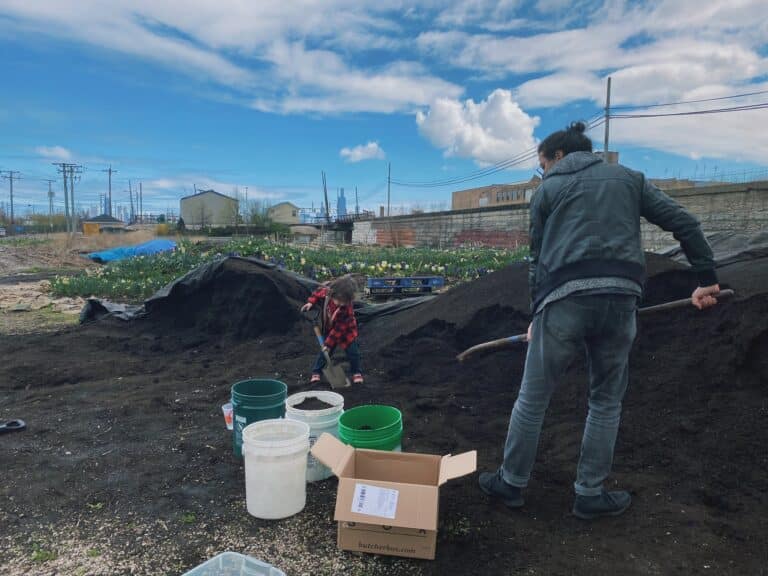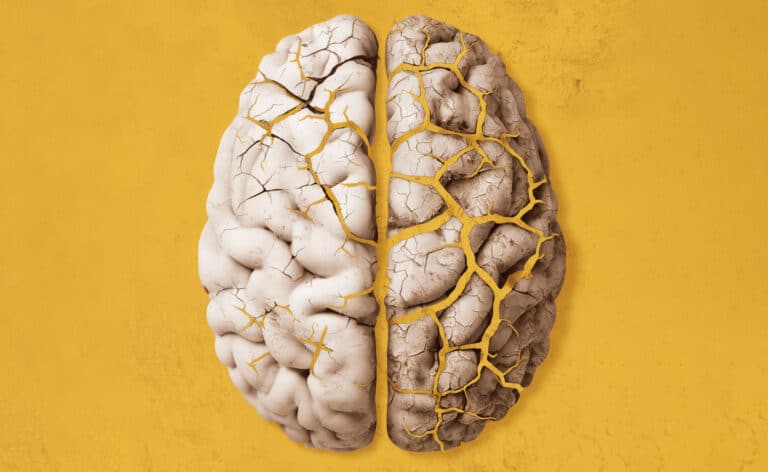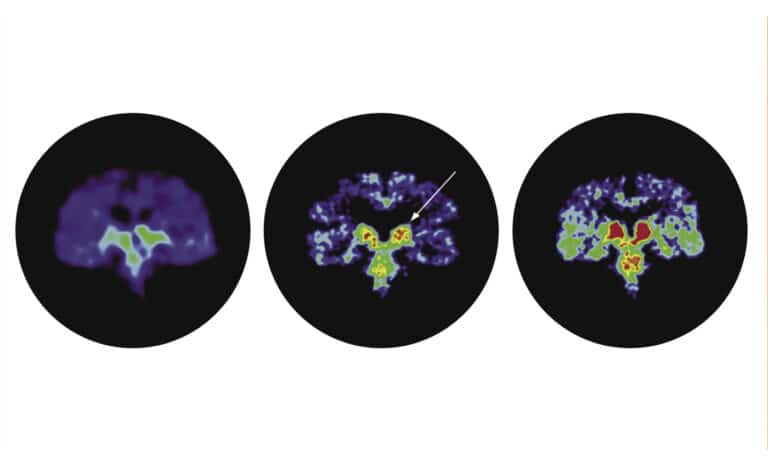From cow cuddling to goat yoga, discover how four-legged friends are transforming health and well-being for people of all ages.
Fact checked by Catherine Gianaro
Oakbrook resident Amy Kopp, 41, had been sick for several years when she decided to try something called cow cuddling. Kopp had stage 4 neuroendocrine cancer of the pancreas that traveled to the liver; she was undergoing treatment for endocrine tumors and taking in food through a tube. She often felt nauseous and exhausted and had just begun walking on her own again.
It was a lot. Yet, while with the cows, Kopp says, “I felt very safe. I didn’t feel sick at all.” The experience allowed her to forget everything she was going through. “I left on cloud nine.”
Dan and Luz Klotz, owners of Luz Farms in Monee, Illinois, where Kopp did her cuddling, learned about cow cuddling during the pandemic when farmers all over Europe were opening their farms for folks who needed hugs. Luz’s initial reaction? “Who the heck is going to pay to hug a cow?”
Today, the Klotzes are busy with eight cows, four goats, one pig, one miniature horse, and thousands of cuddling customers from across the country, many repeat visitors.
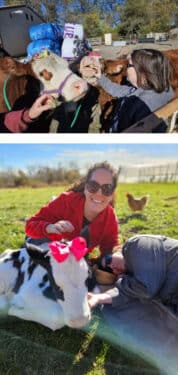
The endorphins that humans release as a result — serotonin, dopamine, and oxytocin — relieve pain, lower stress, and promote a sense of wellbeing. Research shows that petting animals creates an automatic relaxation response.
“I can’t explain how it is, but it shows up in my bones,” Dan says. He has rheumatoid arthritis, but when he is with the cows, he says his body doesn’t hurt. “No Motrin, aspirin, or Humera can do these things.”
Working like a dog
Animals have assisted at Shriners Children’s Chicago since the mid-1990s, according to Darlene Kelly, Shriners’ director of recreation therapy and child life. Kelly founded the hospital’s AAT program, and she brings in dogs and miniature horses to distract, destress, and uplift patients and staff. The animals also help in physical, occupational, and speech therapy.
It’s easy to understand how seeing a miniature horse wearing shoes or a dog walking the hall can distract one from boredom, pain, or missing friends, family, and pets at home. Therapeutically, petting or brushing a dog or horse also can assist with range of motion and fine motor skills.
“It’s fun, goal-oriented activities, such as holding a fork and feeding a dog carrots or green beans, that help with patients’ activities of daily living,” Kelly says. The animals motivate patients to walk farther, mobilize a hand or arm, and learn or remember daily living tasks, such as teeth brushing. Children can often be seen with a leash in their hands as they stroll the hallways with a dog or miniature horse, their therapist, and the animal’s handler.
Kelly recalls one speech therapist who was unsuccessful getting a patient to talk — until a dog walked in, and the child spontaneously exclaimed, “Dog! Dog!”
Each patient’s therapy goal drives the AAT session, says Carol Schuster, president of Rainbow Animal Assisted Therapy in Morton Grove. Rainbow is one of Chicago’s oldest and largest dog therapy organizations, and Shriners Children’s is one of their oldest programs.
In addition to hospitals, animals assist in schools, libraries, rehabilitation clinics, and beyond. After the 2022 mass shooting at the Highland Park Fourth of July parade, for example, Rainbow was called to assist. The dogs helped decompress police officers and first responders, Schuster says. “One of the hospitals that received many of the victims had our dogs continue to visit the emergency room staff for months after the event,” she adds.
Rainbow also worked with the Highland Park High School Band, who were very close to the shooting’s location. “We take our cue from the dogs in community-response situations. The dog will let us know who needs us most,” Schuster says.
When the Rainbow therapy dog team arrived, the band students were seated on risers. Typically in large group situations, the participants remain seated while the dog visits one-to-one. “This day, the dog clearly needed to go up past the first three rows of risers to sit next to a particular child, who petted the dog and burst into tears,” Schuster says.
And while the dogs are paying attention to the people, Rainbow’s therapy teams look out for the dogs. Studies show that dogs’ cortisol levels rise as they work. After 60 minutes, the cortisol rise is significant, Schuster says. So as not to stress the dogs, Rainbow limits their work time to an hour. When working one-on-one, sessions are usually 20 to 30 minutes. “It’s intense work for the dogs,” she says.
Finding confidence through equine therapy
While dogs are a more common therapy animal, horses excel at picking up on humans’ emotions, too.
“A horse’s innate ability to read and respond to mood, intention, and behavior makes them highly effective mirrors,” says Diane Chisman, therapist and owner of Lincolnshire’s Stable Places, an Equine Assisted Psychotherapy and Learning (EAPL) provider. At Stable Places, the barn and outdoors are the office, and the horses — through experiential therapy — become a metaphor for the client’s life. Chisman holds a master’s degree in psychiatric mental health nursing and is certified in EAPL from the Equine Assisted Growth and Learning Association.
EAPL is experience-based. Along with talking, clients move through space or undertake something with their hands. The experiential process can enable what clients are working on to be embedded in a different, deeper, more lasting way, Chisman says.
One man was used to getting things done and moving quickly. Chisman assigned him to move the horses from one spot to another. The client moved toward the horses with in-charge energy. The horses, uninterested, moved away. After exploring the situation, the man realized that he had been functioning in this way for most of his life. Just as his behavior repelled the horses, he had been pushing family and others away, too.
Once the man had real-time awareness, says Chisman, he slowed himself down internally, changing his external expression. The horses then responded completely differently to him.
Chisman works regularly with clients who need specialized attention in such areas as social skills, anxiety, distractibility and confidence. Other clients, who range in age from 4 to 70+, might be dealing with trauma, Lyme disease, or other mental health challenges. “There’s nothing that is inappropriate,” Chisman says.
No horse experience is necessary. No riding is involved. And insurance often covers equine-assisted therapy.
Goat yoga
Then there’s goat yoga. A combination of AAT and yoga, Michele Apps, owner of Nature’s Trail Yoga in Orland Park, says the experience is as gratifying for the goats as it is for the people. “It makes people happy, smile, and feel good. The animals can’t wait to go to class.”
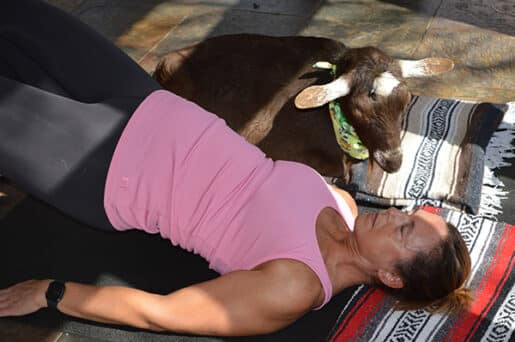
“The goats can sense who needs more attention or emotional support. It’s amazing how intuitive they are,” Apps says. “We had a man come in a wheelchair who was paralyzed from the waist down. He sat on the ground and Cookie [a goat] went right behind his back to support him and laid there the whole class.”
Participants are welcome to pet and hug the goats, as well as put their feet on them. “I’ve had people take a nap and just have their arms around the goat the entire class, which is therapeutic, too,” Apps says. “Even if you come into class grumpy, you’re going to leave smiling.”
Cows, dogs, horses and goats, oh my! The jury is out on who kickstarted this human-animal bond. The connection though, according to research, is prehistoric.

Kathleen Aharoni is a movement and life coach, forest bathing guide, and author of the award-winning book I breathe my own breath! She has served on the faculties of Northwestern University and Columbia College.









